A Duck Punt for the Cordless Canoe Challenge
123
123
|
|
This post was updated on .
[Edited to add:
Read on, dear reader, as the plan has changed! The new boat is now a somewhat modified West Mersea Duck Punt.......] After last years ill-fated effort, I've been torn between having another go, or getting on with the house. Despite all the stuff that needs doing with the house build, the pull of making a new boat has been growing increasingly powerful, pretty much in direct proportion to the slowly lengthening days. The easy thing to do would be to just wash off Aero and have another go with a new drive unit. I've got the drive unit sorted, after last years mishap, so this would be a near-zero effort entry. However, it seems a bit off to enter the same boat twice. Aero is the right sort of size and shape, and near-perfect in my view. The only real drawback is the inability to fit the drive leg on the centre line, where it would almost certainly be more effective. As for the design and build of Aero, I've been doing some experiments. I discovered a fairly cheap source of foam sheet, intended for use as underfloor heating insulation. I've played around with it over the past couple of days and it works well as a core for foam sandwich construction. The samples I've made so far are strong, stiff and light, so the current plan is as follows: 1) Wrap Aero in cling film, place her upside down on trestles and use her as a male mould for the new boat. 2) "Plank" the hull with 10mm thick foam, stuck (temporarily) to the cling film with double sided carpet tape. 3) Fill and fair the foam planks to get a good smooth finish on the outside. 4) Sheath with epoxy/glass, just like a stitch and glue ply boat. 5) When the outside layer of epoxy glass has cured, carefully cut the cling film wrap off from the underside and remove the new hull. 6) Pull off the cling film and double sided tape from the inside, clean it up and lay up another layer of epoxy glass inside. I've weighed the samples I've made and it looks like I can make a hull like this that will weigh about 1.6kg/m² finished weight, which would give a very slightly larger version of Aero at about 2/3rds the weight, I expect. I will probably re-shape the forefoot a bit, too, after I've taken the new hull off and before I've applied the inner laminate. Being made of composite, I can just cut a hole on the centreline for the drive unit, effectively making an outboard well. More details (and photos) will appear in due course..................... |
|
|
Light is good off the water.
One problem you had last year was Aero being blown around while afloat, compounded by the off centre drive. You might want to think about either some ballast system or some sort of keel/skeg/rudder combination to give the boat traction on the water. Tim.
|
|
|
The main problem last year at Beale was that in my haste to fix the new drive, after the original one was broken, I forgot to tighten a grub screw that secured the the input shaft to the lower gearbox shaft, so as soon as the prop was in the water and under load it stopped spinning, so provided no propulsion at all...............
When I've taken Aero out under oar she's been fine, no problems at all with being blown around, in fact she rows tolerably well, although the light weight does mean she loses way between strokes fairly quickly. The upside is that she accelerates quickly and her low displacement means that she is very easily driven. |

|
Chris Waite |
Re: Aero Mk 2 - just for the Cordless Canoe Challenge
|
|
One of the main problems with the CCC is the racing turn at the far end of the course.
Horses for courses indicates a long narrow hull, but with the ability to perform tight turns. A rudder under the bow, that could be linked to another aft unless that is where your prop is going to be, or at least a skeg under the stern, would improve handling and reduce any possible effect from the wind. Then next year they'll all be doing it - just like Formula 1 CW |
|
|
Part of my cunning plan is to fit the propulsion unit towards the stern but in a sort of outboard well, and have it able to rotate for steering via a tiller extension. My hope is that this should allow a tight turn radius around that top buoy, where many of the boats last year seemed to run pretty wide.
The idea of a rhino rudder at the bow is interesting. I flew an experimental aircraft fitted with something similar to a steerable nose wheel years ago and it had a fairly odd effect, but was certainly very powerful; if anything too powerful at times. Aero is probably too directional stable as she is, as the deep forefoot, together with the skeg seem to provide a fair bit of grip on the water. My plan is to cut the forefoot away a bit on the new boat (after removing it from Aero) in the hope that this might make her turn a little better. |
|
|
Very creative and interesting plan Jeremy.
Since your are using foam, is there a further saving in using polyester resin rather than epoxy resin? Most dinghy builders laminate with polyester, and only moved to epoxy when plywood is involved. Polyester resin 5kg pack £17.65 plus vat http://www.cfsnet.co.uk/acatalog/General_Purpose_Resin.html West epoxy 6kg pack £96.23 plus vat http://www.cfsnet.co.uk/acatalog/CFS_Catalogue__West_105_Multi_Purpose_Resin_329.html Brian |
|
|
This post was updated on .
Unfortunately polyester resin is only compatible with either the very expensive foam cores or the structurally poor polyurethane foam used for insulation. The foam I'm using is cheap XPS insulation board, made for underfloor heating, but it's only compatible with epoxy, unfortunately.
In terms of weight, if I get a perfect layup, inside and out, then it should use 3.6 kg of resin. Being realistic it'll probably use 5 kg! The foam weight is less than 2 kg and the glass weight is about 3.6 kg, so total hull weight should be around 10 to 12 kg. Instead of West I'm going to try the Syntac EPAFD resin. It's a fair bit cheaper than West (£65.16 + VAT *** see note added later below!) and based on the samples I tested from the freebies at Beale last year seems pretty good. Plans for the boat are evolving, as I'm being drawn towards a simpler build, based on the West Mersea Duck Punt, but in composite foam. I was intrigued by the performance and looks of these simple little boats when you first posted the info on them, Brian, so I spent an hour or so last night doing some hull resistance calculations. The hull shape, despite being so simple, is remarkably easily driven, as the plot below at 125 kg displacement shows: 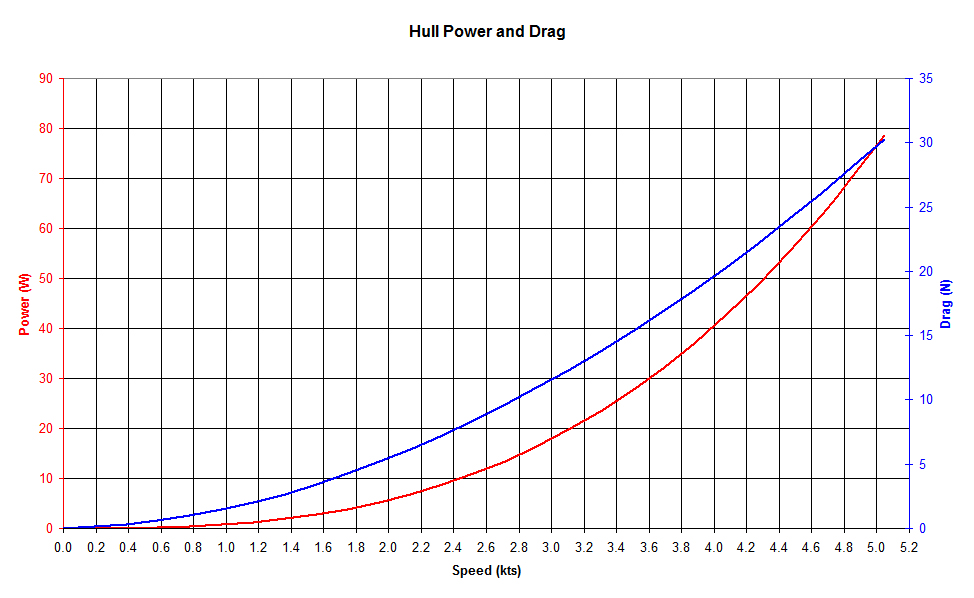 I've re-drawn the duck punt plans (there are some small dimensional errors on the original that give a less than fair curve to the bottom plank) and am currently pondering on whether to make a trip down to the nearest DIY shed for some timber to build a jig................ Edited to add: The Syntac resin arrived a few minutes ago - with no hardener.......... Unlike West, SP and every other resin I've ever bought over the years, where the hardener comes with the resin, with this stuff you need to buy the hardener separately. It's just cost me another £40 odd to get the hardener, so I'm not a happy bunny at all, as I've ended up with probably 50% more resin than I need AND I've had to pay two lots of their fixed postage charge.............. |
|
|
Made a start at cutting out the frame templates for the jig today. One thing that's a bit surprising is how narrow and shallow the Duck Punt is! After marking out the amidships frame template I had to go back and check the drawings, as it looked a wee bit on the small side. All's well, though, so the rest of the jig should get completed over the next day or so, weather permitting (I'm building it out under the car port).
I had a delivery of hardener for the resin this afternoon, a quicker delivery that for the resin I ordered at the weekend. I've wondered whether the people at Syntac read this forum in their quieter moments...............  I strongly suspect that building the boat will be a lot quicker than building the jig, somehow, but the jig could probably be used to build a more conventional ply version too, and may therefore be reusable. |
|
|
Well, I managed to get diverted on to a dozen other things, but with the deadline for CCC entries looming thought I'd better crack on with this. A few hours work this morning saw the jig completed. As soon as the glue has set I'll plane it up and then start cutting out the underfloor insulation foam that the core of the hull will be made from. There's probably more work in the jig than there will be in the hull..........
 
|
|
|
This post was updated on .
The glue hardened pretty quickly (I used the Geocell "5 minute" PU, like Balcotan but much faster!) so I got on with planing the jig stringers fair, taping it up with parcel tape (to stop the glue sticking) and then fitting the internal gunwale strips.
These are the same thickness as the foam and will end up inside the laminate. They act as a positioning aid for the foam "planks" while I'm cutting and fitting them to shape and also provide a bit of internal core strength, which will hopefully make the edge more knock resistant. The next stage is to cut the foam "planks" to size and glue them together and to the gunwale strip. The plan is to use the 5 minute PU glue, with sticky tape to hold the foam in place whilst it cures. The side will be planked first, then when the glue has cured I'll trim them level with the bottom and glue on slightly over size bottom planks of foam. The whole thing will then be trimmed, the edges rounded off a bit to aid laying up the glass cloth, then the outside will be glassed up. With luck it might get planked up tomorrow. 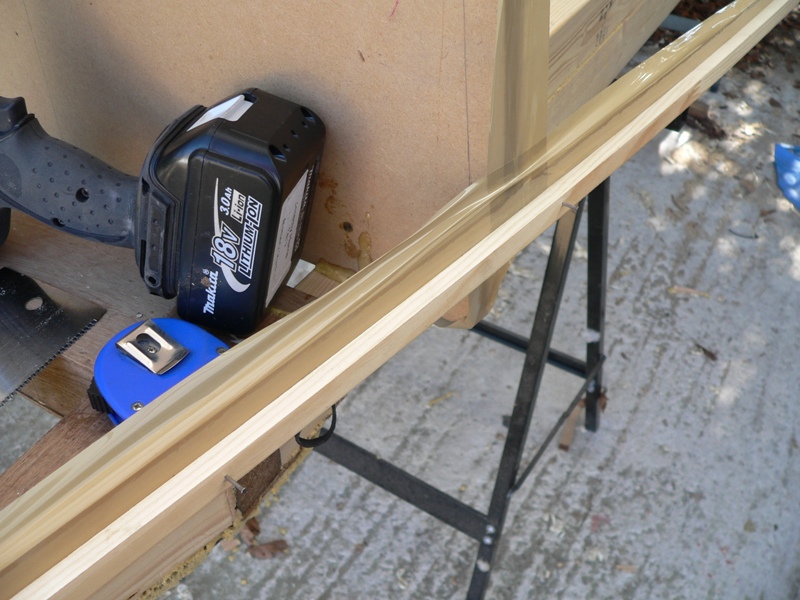 The panel pins holding this in place will be removed after it's been glassed up - the plan is to poke the heads of the pins through the glass cloth as I lay it up, then fill and sand the holes afterwards. 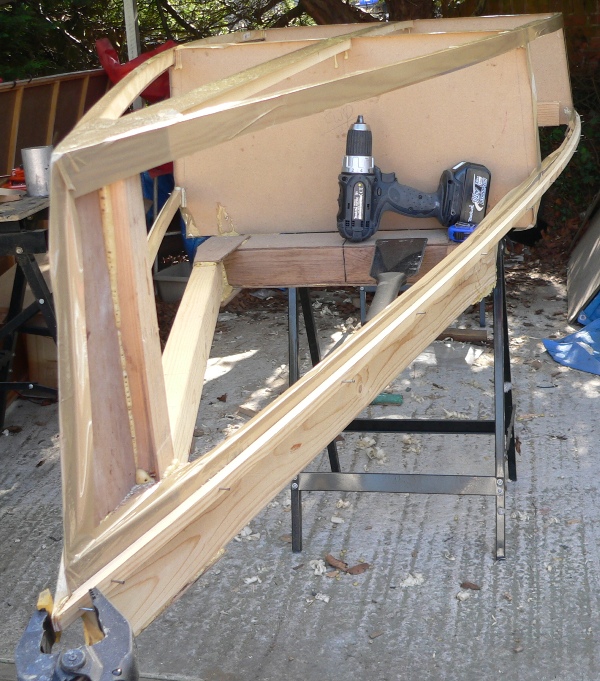
|
|
|
A couple of hours work this morning (slow start, because it was still pretty cold till mid-morning here) has seen both sides planked with foam. It's a pretty quick business, with no real need to spile edges very accurately, as the foam bends in all direction. I found I could leave the straight edges of the sheet as they were and just pull the planks down to the gunwale with a strip of masking tape. All told it's taken more time thinking about it than it has cutting and gluing bits of foam. Even the awkward little twist in the planking where it changes shape to meet the transom was easy enough to do.
The only black spot in the morning was the postman calling midway through the planking, with a smile and a reminder that it's the 100th anniversary of the sinking of the Titanic............. 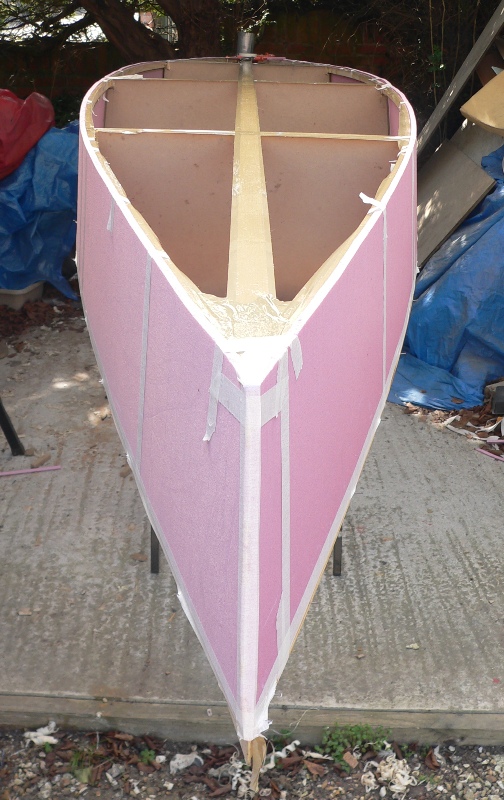 Here's a picture of that awkward little transom twist: 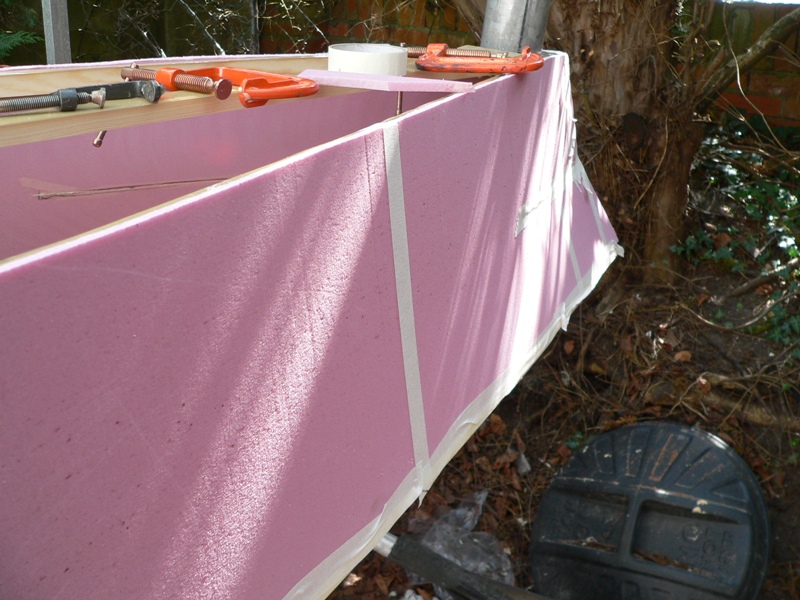
|
|
|
Bit chilly this morning, but half an hour's work has seen the bottom planks cut and fitted.
With luck I might get the first layer of epoxy glass on the hull this afternoon.  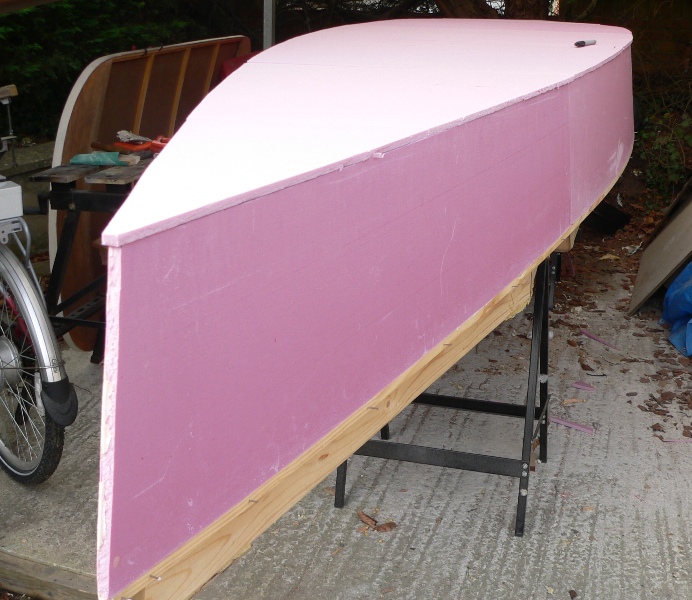
|
|
|
Well, I spent most of today waiting around for the glue to go off on the bottom planks of foam. For some reason it seemed to cure a lot more slowly today than it did yesterday, despite the relative humidity being a fair bit higher (I'm reasonably sure these PU glues are moisture cured).
To pass the time I added a thick layer of unidirectional carbon fibre up the stem, in a cut out in the foam. I covered this with a bit of glass tape and will wrap the 200 g/m² glass cloth I'm covering the hull with over the top too, so I should have a pretty tough little bow. The glue had hardened enough for me to trim and sand the bottom planks in the last half hour or so, but I don't think I'll risk glassing the hull this evening, as it's already cooling down pretty quickly. The hull (ignoring the jig) probably has about three or four hours work in it so far, spread over two days. 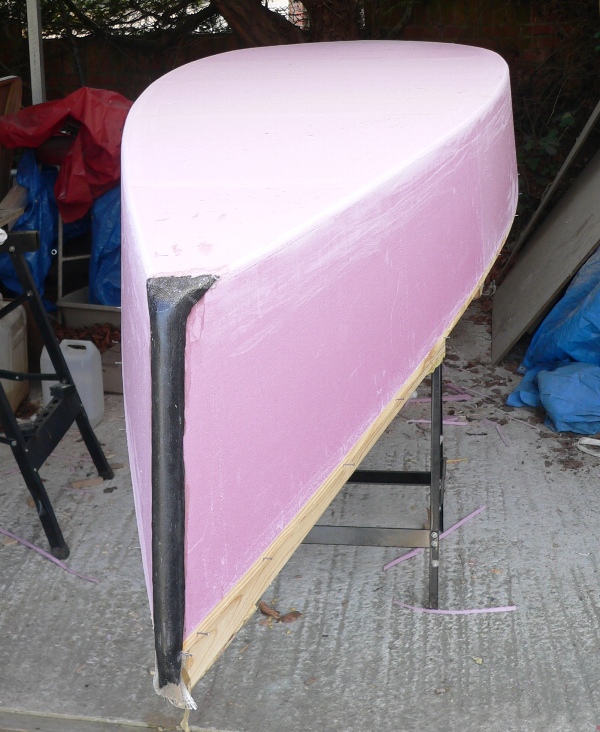
|
|
|
Jeremy,
It's looking good. How much does the underfloor foam retail for? Are you going for a clear finish and keeping it pink  Edit! I've just noticed the web address on the foam labelling in the pictures above. I take it you're using the 10mm foam? |
|
|
I'm not sure about keeping it pink!
The foam is the 10mm stuff, but if you buy it from ebay (as I did) it's a fair bit cheaper than from their online store (it's the same company). Their ebay store is http://stores.ebay.co.uk/the-underfloor-heating-store?_trksid=p4340.l2563 . The hull can just about be planked with 9 sheets, with a bit of care, but I bought 12 to be on the safe side and give me some spare foam for other bits and pieces. The original plan was to use two layers of 200 g/m² cloth but the cloth I have of this weight doesn't want to drape over the hull edge neatly as the weave is too tight. The heavier 300 g/m² woven rovings cloth I have drapes well, as does the lighter 135 g/m² stuff, so the plan is to either give it two layers of 300 g/m² glass or maybe a single layer of 300 g/m² and a layer of 135 g/m² for a bit less weight and a smoother finish. I may double up the thickness of 300 g/m² cloth on the inside of the hull on the bottom, just to give it a bit more ability to take foot loads, as I'm not initially planning on fitting a proper sole. |
|
|
I decided to risk laying up the epoxy glass on the outside yesterday. Not sure this was a good idea, as it didn't get warm enough to use epoxy until midday, and I then spent four hours laying up and squeegeeing the glass. The temperature was around 17 deg C, but had dropped to 14 deg C by the time I finished. Overnight it's dropped to - 1 deg C and the resin (rather predictably) hasn't cured fully.
In theory the resin should cure as soon as it warms up today, so fingers crossed.................. The other mistake was forgetting to get some peel ply. I've managed without, but used maybe 30% more resin that I should have as a result. So far the hull has around 2.6 kg of foam, 0.2 kg of timber around the gunwales, 1.4 kg of glass cloth and 2 kg of resin so should weigh around 6.2 kg. I still have to glass the inside, though, and fit a the various bits and bobs in, so I may or may not come in inside my notional 12 kg estimate. |
|
|
No more work on the hull for the past few days, as the weather's been too cold for epoxy. I just about got away with it earlier in the week, but it took a fair time to eventually cure. Instead I've had to get on with other things.
As many will remember, my Achilles Heel last year was the gearbox breaking. Although this was because of a somewhat unreasonable load being applied (trying to plough the field at Beale Park) I have decided that the drive leg really needs beefing up, to remove the possibility of a similar failure point. I still want a right angle drive at the bottom of the leg, outboard style, but looking at the sizes of gears needed to handle the possible maximum torque from a the drill I've opted for the same sort of gear-less drive that I used on the electric Winsome drive leg. This is a beefy double universal joint that allows almost loss less power transmission through a right angle, with a high torque capacity. The housing is a simple epoxy glass moulding and will be encased in a streamlined drive leg when complete. The inside will be filled with thin oil to keep the ball races in the bearing housings lubricated and to give pressure compensation, so that the seal on the output shaft doesn't see any significant pressure differential. With luck this will be strong enough for the drill to stall before anything breaks................ 
|
|
|
I managed to get the hull off the jig this morning and am contemplating glassing up the inside surface. I think it might well be a bit too cold, with a strong probability of rain, which would push the humidity up above an acceptable level for using epoxy.
Still, at least we can now see what the hull looks like (although currently the gunwales have sprung in around an inch, so need some temporary thwarts to hold them out when I add the inner skin). The hull weight is currently about 6 kg, so pretty much on target. 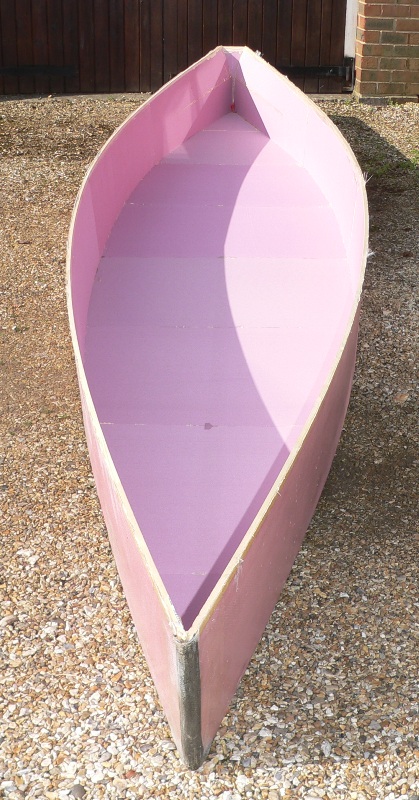
|
|
|
Jeremy, it's looking good; I hope you have accepted the idea of retaining the colour! It will look quite fetching next to Four Candles with its yellow hull and red stabilisers.
6kg is probably less than the motor mounts which I am currently finishing. ps nearly forgot to mention, your hull drag/power chart only goes up to 80w, you will get a lot more than that from a cordless drill, Alan |
|
|
Thanks Alan, but I'll pass on keeping it pink! I believe that cordless drills are OK for around 250 W to 300 W continuous input power (probably only around 200 W continuous output power), but I can't easily simulate speeds over about 5 kts, because that's the onset of significant wave making, so resistance starts to increase at a much greater (and less easy to simulate) rate. Below about 5 kts resistance is virtually all viscous drag from wetted area, so is easy to estimate with a fair degree of accuracy, hence the reason for the plot stopping a bit over "hull speed" (which is a bit over 5 kts for this size boat). |
«
Return to Builds in Progress
|
1 view|%1 views
| Free forum by Nabble | Edit this page |
